Contents
Clematis burning or clematis is a perennial plant of the buttercup family, which is a powerful and strong liana with lush greenery and many small white flowers. Quite easy to care for and at the same time highly decorative, stinging clematis fell in love with many landscape designers and gardeners around the world.
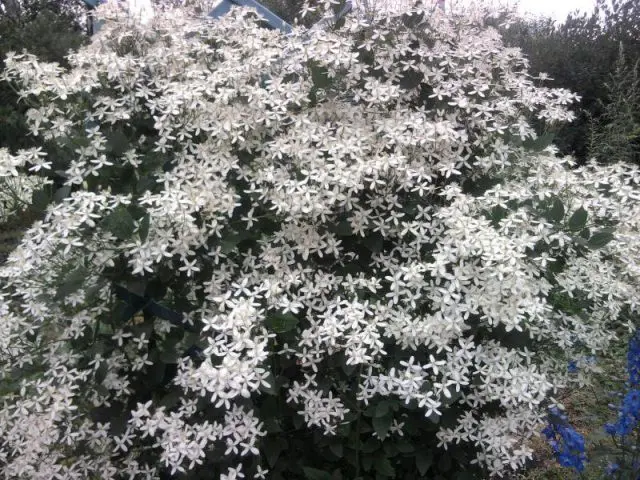
Description of clematis burning
In the natural environment, on the coast of the Black and Mediterranean Seas, burning clematis can reach 3-5 m in height with a diameter of 3-4 m. Clematis prefers forest plantings or thickets of shrubs. In park compositions and private gardens, its dimensions are more modest – up to 1,5 m in height.
Burning clematis (Clematis flammula), also called the vine, refers to woody climbing vines. The plant is characterized by a rapid growth rate, flowers are formed only on the shoots of the current year. Clematis burning small-flowered white in the photo is very similar to other wild-growing species, such as mountain clematis (Clematis montana) or vine-leaved yellow clematis (Clematis vitalba).
Shoots of burning clematis quickly increase their green mass. Many small lanceolate or broadly oval leaves 1,5-4 cm long. The color of the leaf plate varies from emerald green to dark green, the surface is smooth, with an almost imperceptible wax coating.
With the beginning of flowering, which lasts from June to August, the burning clematis bush is transformed: the vine resembles a light white cloud of hundreds of small star flowers. The diameter of clematis flowers does not exceed 2-3 cm, the sepals are obtuse with pubescence along the very edge, the length is 4-10 mm. Flowers are collected in voluminous aerial panicles. One shoot of clematis has from 200 to 400 buds. The flowering of burning clematis is accompanied by a pleasant unobtrusive aroma with hints of honey and almonds. At this time, the plant attracts many insects, honey plants.
After flowering on the burning clematis, you can see red-brown pubescent or bare achenes with a fancy tufted nose up to 7 cm long. Clematis does not lose such an interesting decorative appearance until the end of September.
This type of clematis is called burning due to the special caustic substance produced by its powerful cord-like rhizome. When it comes into contact with the skin or mucous membranes of the mouth and nasal cavity, it causes irritation, which may be accompanied by swelling. The juice of burning clematis is not poisonous; if precautions are taken during plant transplantation, it does not pose a danger to human health.
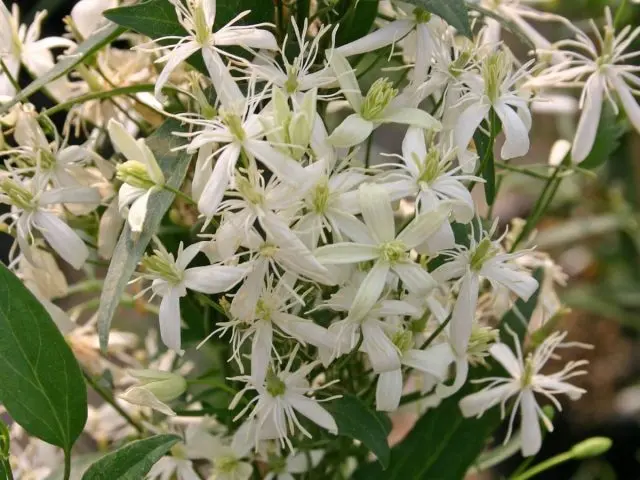
Clematis burning in landscape design
Snow-white stinging clematis is a great option for creating natural landscapes in a wild style. It is used for decoration:
- walls;
- gazebos;
- milk
- pergola;
- fence;
- balconies;
- bare tree trunks.
If you put a support near the clematis, the plant will quickly braid it, forming lush white-green thickets. Often small-flowered clematis is planted as a full-fledged bush or creeping flower carpet. Burning clematis is used as a ground cover plant in the design of garden paths, flower beds, coniferous compositions. Interesting combinations of clematis with crops such as:
- spirea;
- juniper;
- undersized varieties of thuja;
- lilac;
- Chubushnik;
- rose hips;
- forsythia.
Often, eastern clematis and other similar species, contrasting in color, are located next to the burning one. The dense, small foliage of clematis, combined with countless small flowers, creates a romantic atmosphere in the garden and makes the site cozy and well-groomed. For joint vertical gardening are also suitable:
- girlish grapes;
- hop;
- ivy;
- actinidia;
- decorative beans;
- sweet pea;
- nasturtium;
- the guinea pig.
Landscape designers often combine clematis with perennial and annual herbaceous plants. Good neighbors for clematis will be:
- peonies;
- phlox;
- marigold;
- daylilies;
- irises;
- calendula.
Optimal growing conditions
Clematis burning can be grown not only in the fertile warm climate of the Caucasus and the Mediterranean, it grows well and winters in the temperate zone. Clematis loves good lighting and timely watering without stagnant moisture. Growing in the southern regions can be difficult due to overheating of the soil, which clematis endures very painfully. The way out of the situation is to place the vines in partial shade and plant a number of dense annuals.
Planting and caring for clematis stinging
Observing the simple rules of agricultural technology, you can easily grow a white small-flowered clematis in your summer cottage. An optimally selected place, proper planting and subsequent care will ensure abundant flowering and decorative appearance of burning clematis for many years to come.
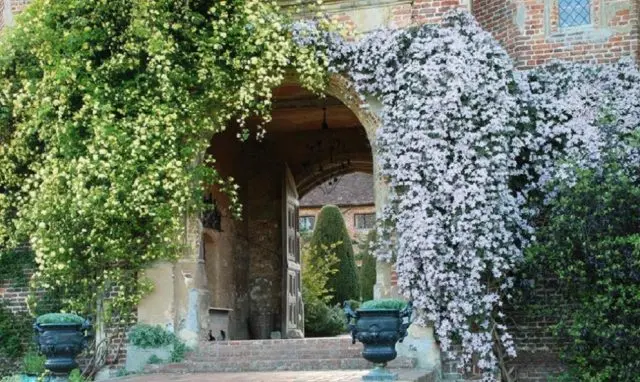
Selection and preparation of the landing site
Burning clematis can grow in one place up to 25 years. It can be placed next to outbuildings, near a gazebo or veranda, arrange an arch or a fence. It is important that the place is windless and well lit, but not located in the sun itself. Planting clematis in partial shade is allowed – this is ideal for a hot climate. Gusts of wind are detrimental to clematis, as they easily break young shoots. Decorative effect suffers from this, and the plant looks dejected.
Like other types of clematis, stinging clematis loves loose, light soil rich in nutrients. The pH reaction should be neutral or slightly alkaline. In acidic soil, before planting clematis, lime should be applied.
Burning clematis does not tolerate close occurrence of groundwater; it is not recommended to plant it in lowlands and wetlands. Excess moisture will inevitably lead to rotting of the root system. Some gardeners get out of the situation by digging special drainage ditches in the immediate vicinity of clematis plantings. During prolonged rains, wood ash is scattered under the bush.
A hole for clematis is dug in advance. Garden soil is mixed with the following ingredients (per 1 m²):
- wood ash – 300 g;
- superphosphate – 150 g;
- peat – 10 l;
- humus – 20 l.
The dimensions of the recess depend on the dimensions of the clematis root system, but not less than 60 cm in width and length, depth – 70 cm. Immediately before planting, the soil can be shed with a weak solution of potassium permanganate.
Seedling preparation
Properly selected planting material is a guarantee of health and abundant flowering of clematis. When examining seedlings in the nursery, you should pay attention to the following nuances:
- the plant should not have mechanical damage;
- pests and signs of any diseases should be absent;
- the root system must have at least 5 roots;
- an autumn clematis seedling should have 2 shoots, a spring one should have at least one.
The best time to buy young clematis is mid-September. 2-year-old seedlings with a closed root system have the highest survival rate. Before planting, the shoots of burning clematis are cut off, leaving 1-5 buds.
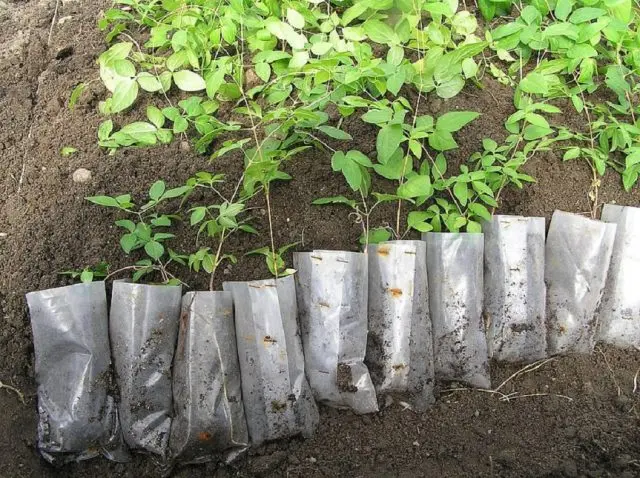
Rules for planting clematis burning
Burning clematis is planted in open ground in spring or early autumn. In areas with a temperate cool climate, spring planting is more appropriate, in the south – on the contrary, autumn. Planting clematis burning is easy, however, you need to follow a few rules:
- A support is installed at the bottom of the pit dug in advance and covered with a layer of drainage made of pebbles, broken bricks, crushed stone, expanded clay or coarse-grained river sand.
- A layer of fertile soil is laid on the drainage in the form of a mound, on which the seedling is placed, spreading the roots.
- Young clematis is covered with earth so that the root neck is 10 cm below ground level, and something like a funnel or crater is formed around it.
- Clematis seedlings are abundantly watered with warm settled water and mulched with a generous layer of peat.
- In the first weeks after planting, clematis is shaded from direct sunlight.
Watering and top dressing
Small-flowered clematis loves moisture, you need to water the vine once a week, and on hot dry days – 1-2 times. To do this, it is better to use a watering can without a diffuser, pour water under the root, trying not to get on the leaves and stems. Inaccurate irrigation of the ground part of the burning clematis can lead to its withering. Young clematis bushes consume much more moisture than adult perennial vines.
In order for the burning clematis to please the gardener with lush and juicy foliage, as well as abundant and long flowering, it must be fed in a timely manner. During the period of active vegetation, organic and mineral fertilizers are alternately applied to the soil around the clematis, observing an interval of 20-25 days.
Nitrogen and its compounds, so necessary for active growth, are found in organic matter (manure, chicken manure). They are mixed with water and insisted – this contributes to better absorption of nutrients by the roots of the plant. In the absence of litter or manure, burning clematis can be fed with urea (urea).
To ensure high-quality budding and lush long flowering, burning clematis is fertilized with a complex mineral agent, for example, nitrophoska.
When burning clematis begins to bloom, they try not to feed it, especially with products containing a large amount of nitrogen. This will provoke the vine to increase the green mass to the detriment of flowering. When the burning clematis fades, potash-phosphorus fertilizers are applied to the root zone. It is better to feed the vine immediately after the next watering.
Mulching and loosening
To increase the air permeability of the soil, the circumferential circle is periodically loosened, while removing weeds. The procedure should be carried out after watering or rain. To reduce the evaporation of moisture from the soil surface, burning clematis is mulched with sawdust, humus, peat or fallen leaves. Several times a season, the mulch layer is changed to a new one.
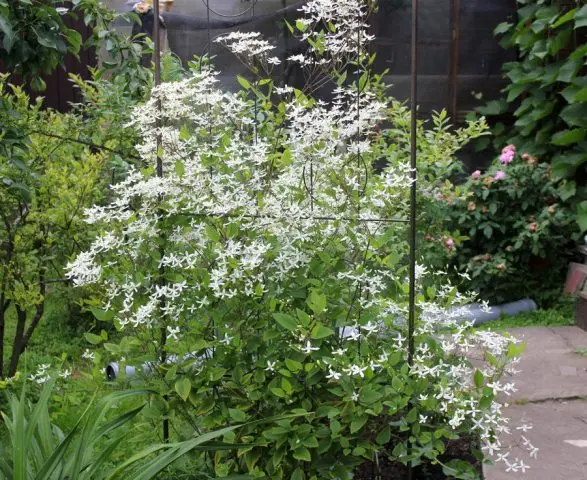
Garter
Young fast-growing shoots of burning clematis are characterized by increased fragility and need a timely garter to a support. To do this, use raffia, twine or plastic clips. The lower part of the clematis bush is fixed to a mesh or wooden structure with a wire. Creepers are tied in one layer so that light and air can easily penetrate to any part of the plant. Otherwise, burning clematis will suffer from various diseases caused by lack of light and high humidity.
Trimming
In the spring, for more spectacular and prolonged flowering, several side shoots are cut from clematis. During the entire warm season, dried or damaged branches are removed. To do this, use a well-sharpened garden pruner, disinfected in a solution of potassium permanganate or alcohol. In autumn, cardinal pruning of all clematis shoots is carried out, leaving only a few nodes above the ground.
Preparation for winter
After autumn pruning, the near-stem circle is spudded with mulch or dry earth, a wooden box is placed on top, covered with a thick layer of sawdust, peat or leaf litter. A thick plastic film with ventilation holes made in it is fixed on the shelter. In this form, the rhizome of burning clematis will calmly endure even the most severe and snowless winter.
Reproduction
Clematis stinging can be propagated both vegetatively and generatively. Each of the methods has its advantages and disadvantages:
- seed. Clematis burning small-flowered white is a natural species, so seedlings grown from seeds will exactly repeat all the characteristics of the mother plant. Future seed is collected from clematis at the end of October. Seeds are cleaned of fluff and tufts, placed in containers with wet coarse sand and refrigerated for 2-3 months for stratification. In April-May, clematis seeds are sown in a sand-peat mixture on the surface of the soil, sprinkled with a thin layer of sand on top. Seedling care comes down to regular watering. When 2-3 true leaves form on young clematis, they can be dived into separate containers. The bushes will be ready for transplanting to a permanent place in the garden only next spring.
- Layering. In spring, a shallow groove is dug near the clematis bush, into which a strong healthy vine is placed and fixed with special metal brackets. After the appearance of new shoots on the layering, it is lightly sprinkled with earth. A year later, the allotted shoot is carefully removed from the ground and cut into separate seedlings, which are immediately determined to a permanent place.
- Cuttings. For cuttings, both green and lignified shoots of clematis are suitable. They are cut with a length of 8-10 cm so that the upper cut above the knot is straight, and the lower cut is at an angle of 45 °. The leaves below the node are cut off, the tips of the cuttings are treated with a growth stimulator (Kornevin or Heteroauxin preparations) and planted in a greenhouse, in a loose nutrient substrate. After 1,5-2 months, the root system of young vines will be ready for transplanting to a permanent place or to growing beds.
- Division of the bush. Adult burning clematis is dug in from all sides or completely removed from the ground. The bush is divided into several parts so that each has a good rhizome and several shoots with vegetative buds. Clematis delenki are immediately planted in a permanent place.
Diseases and pests
Clematis stinging most often suffers from fungal infections. Clematis pests are:
- aphid;
- bear;
- slippery;
- snails;
- gall nematoda;
- caterpillars;
- spider mite;
- rodents.

The table below describes the most common diseases and pests of stinging clematis, as well as control and prevention measures.
| Disease or pest | Description | Control and prevention measures |
| Rust | Rust on clematis burning appears as red spots on young shoots, petioles and leaves. If left untreated, deformation of the shoots occurs, browning and twisting of the leaves, which subsequently dry out and fall off. | For the purpose of prevention, weeds should be weeded in a timely manner and the affected fragments of the vine should be cut off. When clematis is infected with rust, a 1% solution of Bordeaux liquid, copper oxychloride (HOM), Topaz, Gamair preparations are used |
| Gray mold | In cloudy and rainy summers, the leaves and petals of burning clematis can become covered with brownish spots with a gray fluff. These are the first signs of infection with gray rot. Over time, young shoots and leaves die off, clematis stops growing. The spores of the fungus Botrytis cinerea are easily carried by the wind and quickly infect other horticultural crops. | Waterlogging of the soil near the clematis should not be allowed. To combat the bushes of burning clematis, they are treated with the preparations “Azocen”, “Gamair”, “Fundazol” |
| Mučnistaâ rosa | At the height of summer, stinging clematis can be affected by powdery mildew. Leaf plates, green shoots, flowers and buds are covered with a gray-white bloom resembling flour. Affected fragments quickly change color to brown and die off. | Preventive measures against powdery mildew – timely watering without waterlogging, treatment of clematis plantings with cow’s milk diluted in water. For treatment, Fitosporin-M, Topaz, Baktofit, Alirin-B, soda ash diluted in water (40 g per 10 l) are used. |
| verticillium wilt (wilt) | The first sign of wilt on clematis stinging is the withering of the tips of the shoots, especially young ones. This is the result of the activity of pathogenic fungi living in the soil and, under favorable conditions, penetrating the stems of the plant. The vessels in the core of the stem are damaged and clogged by the mycelium of the fungus, nutrients are supplied in insufficient volume. The disease spreads very quickly – several lashes can dry out in a day. | Do not plant burning clematis in a shaded place with heavy and acidic soil. It is important to tie clematis in a timely manner, remove weeds and not overfeed with nitrogen. The peak activity of the fungus occurs at a temperature of 23-26°C and an increased level of humidity. Bushes of burning clematis are treated with a 1% solution of copper sulfate, “Trichodermin”, “Gliocladin”, a copper-soap solution. In some cases, it is not possible to save the clematis, they dig it up and burn it. |
| aphid | At the beginning of summer, aphids become active on the tops of young shoots of stinging clematis. Numerous small insects literally stick around the clematis, sucking out the plant juice and releasing a sticky liquid. Gradually, the shoots dry out and die | Aphids are mechanically removed from burning clematis (by washing with a stream of water), beneficial insects and birds are attracted to the garden, folk methods are used (spraying with infusions of tomato tops, garlic, onion peel). The most effective use of modern bioinsecticides, such as “Fitoverm-M” |
| Snails and slugs | With the advent of the warm season, burning clematis is attacked by slugs and snails. They eat the soft tissues of clematis, in particular the kidneys. | Pests are harvested by hand, wood ash, lime, superphosphate, granular metaldehyde are used to scare and fight. |
| spider mite | You can notice that burning clematis is affected by a spider mite by the presence of sticky thick cobwebs on the leaves and shoots. Ticks pierce the leaf plate of clematis from the underside and feed on the sap of the plant. Small yellow spots appear in these places, over time, the affected fragments lose color and dry out. | Ticks become active during hot and dry weather, usually in the middle of summer. It is difficult to get rid of the pest, you will have to treat the ground part of the burning clematis three times with strong insecticides, such as Aktellik, Akarin, Antikleshch |
| Gall nematode | Nematode roundworms infect the root system of clematis, provoking the formation of thickenings that disrupt the normal nutrition of clematis. Liana looks oppressed, pale, growth slows down. Young seedlings of stinging clematis may die | Pests are repelled by planting marigolds and calendula. As well as mulching the near-trunk circle of clematis with mint or wormwood. It is necessary to add compounds containing ammonia (ammonium nitrate or ammonium sulfate) |
Conclusion
Clematis stinging is an unpretentious fast-growing vine that will decorate any garden. Snow-white foam of small flowers with a delicate honey aroma can transform the most unprepossessing places of the site, draping them with its dense foliage. Cultivation of burning clematis is within the power of even a novice gardener.









